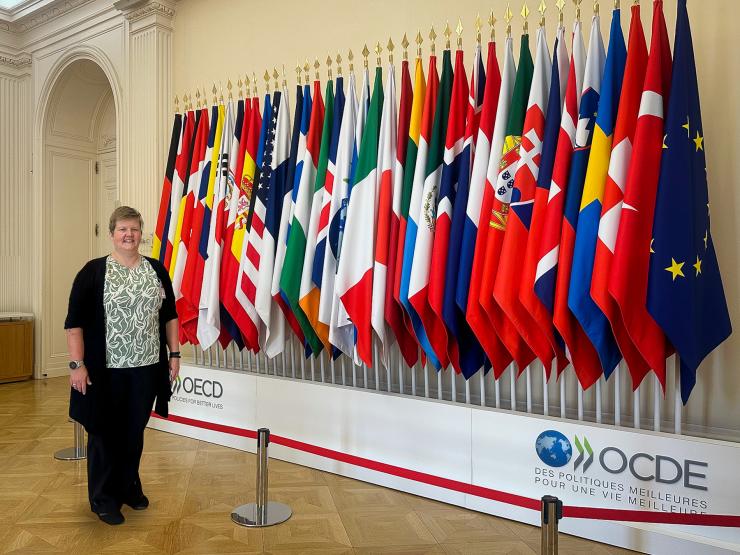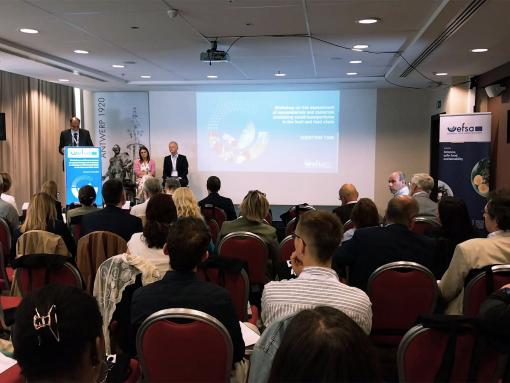Summary of the Joint Regulatory Risk Assessor Summit
Advancing Safety & Sustainability Assessment of Advanced Materials
19–20 June 2025, Paris, OECD
Co-hosted by four Horizon Europe-funded projects (ACCORDs, iCARE, MACRAMÉ, nanoPASS), the recent summit aimed to support the EU’s Green Deal through improved methodologies for assessing the health and environmental risks of advanced materials (AdMas), particularly at the nanoscale. These projects develop and harmonise high-resolution imaging, in vitro models, validated protocols, and computational tools for better nanosafety and material characterisation.
Four Projects, Each with a Distinct Nano-Focus
- MACRAMÉ targeted inhalable carbon-based AdMas (e.g., graphene-related materials, CNTs, PLGA particles) using case studies across five industries. It emphasised standardisation of novel detection and characterisation methods.
- ACCORDs developed a three-tiered characterisation framework (phys-chem analysis, bio-interaction, and bio-characterisation) scaled from lab-screening to organ-specific tests at competence centres.
- nanoPASS addressed long-term adverse effects of inhaled nanoparticles (lung, heart, brain) with validated in vitro/in silico models calibrated to over 40 benchmark materials. It bridged regulatory and industrial needs, prioritising mechanism-based, animal-free safety predictions.
- iCARE focused on neurotoxicity, developing advanced imaging and in vitro CNS models and applying them in industrial cases. The project also contributed regulatory recommendations and aimed for long-term legacy and adoption.
Emphasis on Regulatory Certainty for Nanomaterials
The keynote given by Eric Bleeker (RIVM) contextualised these projects within the broader evolution from nanomaterials to advanced materials, emphasising challenges around regulatory uncertainty. Especially, he noted; legal definitions and risk assessment tools, the need for harmonisation, standardisation, and FAIR data for risk governance and the OECD’s definition of AdMas (Materials rationally designed for enhanced performance, including nanostructured, hybrid, and composite materials produced through innovative manufacturing). He stressed the increasing complexity of AdMas, often composed of multiple material types, and referenced a range of intersecting EU regulations and sustainability initiatives (e.g., Waste, General Product legislation, Green Deal, SSbD, REACH). He also introduced draft recommendations covering 12 priority areas (e.g., sample prep, dosimetry, lifecycle assessment, release testing, multi-component AdMas, information sharing).
Insights from Nanomaterial Stakeholders
A panel discussion gave key stakeholder insights from OECD, ECHA, RIVM, BIAC, LIST and Malta-Initiative:
- Highlighting the importance of harmonised regulatory standards (e.g., OECD Test Guidelines), as inconsistent regulation could either hinder innovation or fail to manage risks & framing safety as a key enabler of innovation.
- Calling for governance systems that can adapt to the rapid pace of material innovation, noting conventional (eco)toxicology may not suffice for AdMas.
- Emphasising flexible, property-based regulatory frameworks and better communication between regulators, academia, and industry.
- Advocating for targeted, science-based updates to existing guidelines rather than full revisions, to improve efficiency and minimise costs.
- Stressing that legislation must keep pace with innovation to ensure public trust.
- Pointing out the mismatch between research and regulatory timelines. Urged follow-up to ensure validated methods transition into practical and regulatory applications.
- Advocating for a structured dialogue between developers and regulators to ensure new methods align with regulatory requirements and questioned how to accelerate OECD TG/GD approval processes.
Common Themes of the Regulatory Summit
- Translational challenges remain: many tools are developed but not yet regulatory-ready.
- Stakeholder engagement must deepen, with clearer communication channels and mutual understanding of needs and limitations.
- Science-regulation translation is critical, with specific individuals (e.g., RIVM’s role) positioned to bridge the gap.
- Regulatory pragmatism and prioritisation (e.g., Malta Initiative’s priority list) are necessary for timely adoption of methods.
- Safety is not a barrier but a prerequisite for innovation and public trust.
Safe, Sustainable & Innovation Friendly Nano Regulation
The summit underscored the shared urgency of developing coherent, science-backed, and harmonised frameworks for assessing advanced materials while taking lessons learned from 15+ years of nanomaterial research into account. It called for stronger cross-sector collaboration, regulatory adaptability, and a collective push toward a safe, sustainable, and innovation-friendly materials landscape.
Our nanomaterial regulatory compliance experts are actively involved in the shaping of nanomaterial regulation – bridging the gap between regulation and industry. If you have any queries relating to the regulation of nanomaterials, call or email and speak with one of our nano team directly.



